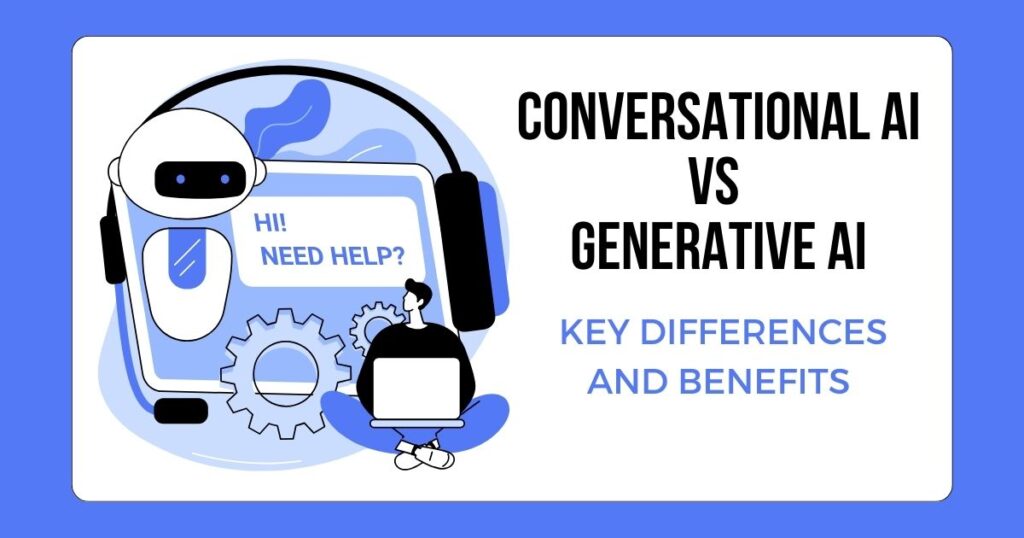Are you ready to dive into the intriguing world of Conversational AI vs Generative AI? It’s a battle of two extraordinary technologies, each wielding its unique set of superpowers. If you’re looking to demystify the enigma surrounding these cutting-edge AI domains, you’ve come to the right place. Conversational AI, with its ability to engage in natural, human-like conversations, has captured the hearts and minds of many. On the other side of the ring, we have Generative AI, a true wizard when it comes to creating content that’s not just coherent but creatively impeccable.
In this blog, we’ll unravel the spellbinding distinctions between these two AI titans, and more importantly, we’ll explore the incredible benefits they bring to the table. From revolutionizing customer support to crafting literary masterpieces, these AI innovations are reshaping industries. Whether you’re a tech enthusiast, a business owner, or just curious about the future of AI, stick around, because we’re about to embark on a captivating journey through the realm of Conversational AI vs Generative AI, and the possibilities they hold are nothing short of astonishing. Ready to explore? Let’s get started!
Defining Conversational AI vs Generative AI
Conversational AI vs Generative AI are two intriguing concepts reshaping the landscape of human-computer interaction. Conversational AI refers to a class of AI systems designed to engage in natural, human-like conversations. These systems, underpinned by technologies like Natural Language Processing (NLP) and Machine Learning, can comprehend and respond to user inputs, creating a seamless conversational experience.
On the other hand, Generative AI involves the creation of content, be it text, images, or even music, through AI models capable of generating entirely novel and coherent data. One of the prime examples is the GPT-3 model, which generates human-like text with astonishing fluency and creativity.
Consequently, these technologies are revolutionizing industries such as customer service, content creation, and more. Businesses and researchers are tapping into the potential of Conversational AI vs Generative AI to enhance user experiences, automate tasks, and explore the uncharted realms of creative AI-driven content generation. The synergy between these AI branches is driving innovation and opening new horizons in human-computer interaction.
Understanding Conversational AI

What Is Conversational AI?
Conversational AI, short for Conversational Artificial Intelligence, is a branch of artificial intelligence that focuses on enabling computers and machines to engage in natural, human-like conversations with users. It aims to create systems that can understand and generate human language, facilitating seamless interaction between machines and humans. Conversational AI systems can understand spoken or written language and respond appropriately, making them an integral part of many modern applications.
Applications of Conversational AI
There is a wide range of applications for conversational AI in multiple industries. Two prominent applications include:
Chatbots: A chatbot is a computer program that simulates a human conversation. They are often used on websites, messaging apps, and social media platforms to answer frequently asked questions, provide customer support, or assist with various tasks. Chatbots are particularly useful in streamlining customer service and automating routine interactions.
Virtual Assistants: Virtual assistants like Siri, Alexa, and Google Assistant are popular examples of conversational AI. These systems are integrated into smartphones and smart devices, allowing users to perform tasks such as setting reminders, checking the weather, or controlling smart home devices through natural language voice commands.
How Does Conversational AI Work?
Conversational AI systems rely on a combination of technologies to understand and generate human language. Two key components of how Conversational AI works are:
Natural Language Processing (NLP) and Machine Learning: NLP is a field of artificial intelligence that focuses on the interaction between computers and human language. Machine learning algorithms play a crucial role in training conversational AI models. These models analyze vast amounts of text and speech data to understand the nuances of language, including context, semantics, and sentiment. NLP techniques, such as tokenization, named entity recognition, and sentiment analysis, help the system comprehend and interpret user input.
User Interaction: The user interaction aspect of conversational AI involves the way users engage with the system. This can happen through text-based chat interfaces, voice commands, or even through a combination of both. Conversational AI systems are designed to be user-friendly and responsive, aiming to provide a natural and intuitive conversation experience. They use the insights gained from NLP and machine learning to generate relevant and coherent responses to user queries.
Understanding Generative AI

Generative AI, short for Generative Artificial Intelligence, is a subset of artificial intelligence (AI) that focuses on creating algorithms and models capable of generating data, content, or outputs that resemble human-generated content. It has gained significant attention and relevance in various fields due to its ability to produce realistic, contextually relevant outputs across different domains.
What Is Generative AI?
Generative AI encompasses a wide range of techniques and models, but at its core, it involves the development of systems that can create data, such as text, images, music, and more, without explicit human input. These systems learn from large datasets, and once trained, they can generate new content that mimics the patterns and styles present in the training data. In essence, generative AI enables computers to generate content that is often indistinguishable from human-generated content.
Applications of Generative AI
Generative AI has numerous applications, two of which stand out prominently: text generation and content creation.
Text Generation: is a notable application of generative AI. Models like GPT-3 and GPT-4 have gained fame for their capacity to generate coherent, contextually relevant text. These models have applications in natural language processing tasks such as chatbots, content generation, language translation, and more. They can draft articles, answer questions, or even generate code snippets.
Content Creation: is another pivotal application. Generative AI can produce images, music, and even video content. For instance, it has been used to generate artwork, music compositions, and deepfake videos, transforming the creative landscape and raising ethical concerns about content authenticity.
How Does Generative AI Work?
Generative AI operates through the utilization of deep learning models, extensive training, and carefully curated data.
Deep Learning Models: form the backbone of generative AI. These models are often neural networks with multiple layers. Variational Autoencoders (VAEs) and Generative Adversarial Networks (GANs) are popular choices. GANs consist of a generator and discriminator, which compete to improve the quality of generated content. This adversarial process helps the model learn and refine its output.
Training and Data: are integral to generative AI. These models require vast datasets for training, which can be texts, images, or other types of content. During training, the model learns the patterns and structures inherent in the data, enabling it to generate coherent and contextually relevant content. The quality and diversity of the training data significantly impact the model’s performance. Ethical considerations also come into play, as training data should be carefully selected and processed to avoid biases and undesirable outputs.
key differences between Conversational AI vs Generative AI
Data sources and training methodologies
Conversational AI vs Generative AI differ significantly in their data sources and training methodologies. Conversational AI systems, such as chatbots or virtual assistants, are typically trained on specific datasets that consist of human-to-machine interactions. These datasets may include a wide range of conversations, scripts, or dialogues to help the AI understand and generate appropriate responses within a predefined context. Generative AI, on the other hand, often leverages larger and more diverse datasets, which encompass a wide array of text, including books, articles, and internet content. The training methodology for generative AI involves unsupervised learning, allowing the model to generate creative and contextually diverse text.
Application areas and use cases
Conversational AI vs Generative AI are applied in distinct use cases. Conversational AI primarily finds its application in customer support, virtual assistance, and human-computer interaction. It’s designed to provide immediate, contextually relevant responses to user queries. Generative AI, however, is more versatile and can be employed in creative writing, content generation, and language translation. It excels in tasks that require the generation of original, contextually rich text, and it can be used in various industries beyond just conversation-based applications.
Human interaction and user experience:
User experience varies significantly between Conversational AI vs Generative AI. Conversational AI aims to replicate natural human interaction, focusing on providing users with a seamless and user-friendly experience. It emphasizes maintaining a structured conversation, understanding context, and generating responses that mimic human speech patterns. Generative AI, while capable of producing high-quality text, may not always prioritize user-friendliness as its primary objective. Its focus is on generating content based on patterns in the training data, which may not always align with the conversational flow users expect.
Flexibility and adaptability in responses:
Conversational AI systems are engineered to offer predefined, contextually relevant responses. They are highly adaptable within their predefined domains but may struggle to generate responses outside of their training data or specific use cases. Generative AI, in contrast, offers greater flexibility. It can generate a wider range of responses and adapt to various contexts, thanks to its extensive training data. However, this flexibility can be a double-edged sword, as it may produce text that is less predictable or less constrained within certain applications.
Learning capabilities and scalability
The learning capabilities and scalability of Conversational AI vs Generative AI differ significantly. Conversational AI systems typically rely on supervised learning and are designed for specific tasks, making them less adaptable to new tasks without extensive retraining. Generative AI is inherently more scalable and can be fine-tuned for a wide range of applications, thanks to its unsupervised learning approach. It excels at learning patterns from diverse data sources and can be adapted to various domains and languages, making it a more versatile choice for organizations looking for scalable AI solutions.
Benefits of Conversational AI
Improved customer service and support
Conversational AI, such as chatbots and virtual assistants, plays a pivotal role in enhancing customer service and support. These AI systems are capable of providing instant responses to customer queries, troubleshooting problems, and offering assistance round the clock. They ensure consistent and reliable support, reducing the waiting time for customers, and increasing their overall satisfaction. Conversational AI can also handle routine, repetitive inquiries, freeing up human agents to focus on more complex issues, thus improving efficiency.
Time and cost efficiency in handling queries
One of the most prominent benefits of Conversational AI is its ability to streamline query handling processes. These AI systems can quickly and accurately resolve common queries, reducing the workload on customer service teams.This not only results in time savings but also reduces operational expenses. The automation of routine tasks allows organizations to allocate resources more efficiently and allocate human expertise where it’s needed most.
Personalization and user engagement
Conversational AI leverages data and user preferences to deliver highly personalized interactions. By analyzing user data, AI systems can tailor responses and recommendations to individual needs, preferences, and behavior. This level of personalization enhances user engagement and satisfaction, ultimately improving the user experience. The more personalized the interaction, the more likely customers are to feel valued and understood.
Scalability and 24/7 availability
Conversational AI systems are easily scalable, making them invaluable for businesses dealing with fluctuating demand. They can handle a virtually limitless number of interactions simultaneously, ensuring that no customer query goes unanswered. The 24/7 availability of these AI systems accommodates global audiences, different time zones, and customers who prefer to seek assistance outside regular business hours, enhancing accessibility.
Data insights and analytics
Conversational AI generates a wealth of data through interactions with customers. This data can be invaluable for businesses, offering insights into customer behavior, preferences, pain points, and frequently asked questions. By analyzing this data, organizations can make informed decisions, fine-tune their products or services, and create more effective marketing strategies. The data-driven approach helps companies stay competitive and responsive to market changes.
Benefits of Generative AI
Content creation and automation
Generative AI, with its ability to generate human-like text and content, streamlines content creation processes. It can be used for automated content generation, such as writing articles, product descriptions, and marketing copy. This not only reduces the time and effort required for content creation but also helps maintain consistency in tone and style.
Creative and artistic applications
Generative AI has found applications in the creative and artistic realms. It can assist artists, writers, and designers in generating new ideas, artworks, or even music. By augmenting human creativity, it serves as a valuable tool for producing unique and innovative works across various creative domains.
Language translation and localization
Generative AI has made significant advancements in the field of language translation and localization. It can automatically translate content between multiple languages while preserving context and tone. This simplifies the process of reaching global audiences, making it easier for businesses to expand internationally.
Natural language understanding and generation
Generative AI models are capable of understanding and generating human-like text, which is pivotal for applications like chatbots, virtual assistants, and even mental health support systems. They can engage in more natural and context-aware conversations, enhancing user experiences.
Research and development possibilities:
Generative AI is a valuable tool for research and development in various fields, including healthcare, finance, and science. Researchers can use it to process and analyze large volumes of data, simulate scenarios, and generate hypotheses. This accelerates the pace of innovation and scientific discovery, leading to potential breakthroughs in these domains.
Considerations for Choosing the Right AI Approach
Factors to consider when selecting Conversational AI
When selecting Conversational AI, there are several crucial factors to consider. Firstly, you should evaluate the complexity of the conversations you intend to have with the AI. If you need simple, rule-based interactions, a chatbot might suffice, but for more sophisticated, context-aware conversations, a natural language understanding (NLU) system is necessary.
Moreover, the platform’s ability to integrate with your existing systems and data sources is vital, as it affects how well the AI can access and utilize relevant information. Consider the scalability of the Conversational AI solution, especially if your needs might expand in the future. Another vital aspect is the quality of the user experience; it should be user-friendly and provide seamless interactions. Lastly, cost considerations, including initial setup, training, and ongoing maintenance, should be assessed to ensure the AI solution aligns with your budget.
Factors to consider when selecting Generative AI
Selecting Generative AI requires a different set of considerations.The foremost consideration is the paramount quality of the content generated. The AI should produce text, images, or other forms of content that meet your specific requirements, whether it’s for content generation, creative applications, or other use cases. Consider the model’s flexibility and customization capabilities. Some Generative AI models allow fine-tuning for specific tasks or domains, while others may be more versatile.
Model training and data requirements should also be factored in; some Generative AI systems need extensive data and computational resources. Ethical considerations are essential as well. Be mindful of the potential for bias in the AI’s outputs and ensure it adheres to ethical standards. Lastly, regulatory compliance is crucial, as many industries have specific requirements regarding content generation and data usage.
Identifying the most suitable AI solution for your specific needs
Identifying the most suitable AI solution for your specific needs involves a holistic assessment. Start by defining your goals, whether it’s to improve customer support, generate creative content, or optimize business processes. Understand the data and resource requirements for your chosen AI approach. Conduct a pilot or proof-of-concept project to evaluate the AI’s performance in a real-world scenario. Seek feedback from end-users to ensure it aligns with their expectations and requirements. Additionally, consider the long-term implications, including scalability and maintenance. Keep an eye on the market for emerging technologies that might better address your needs. Finally, engage with experts or consult with AI vendors who can provide valuable insights and guidance to ensure you make an informed decision.
Future Trends in Conversational AI vs Generative AI

Potential advancements in technology
The future of Conversational and Generative AI is likely to witness several exciting advancements. In Conversational AI, we can expect more sophisticated natural language understanding (NLU) and natural language generation (NLG) models that can engage in more nuanced and context-aware conversations. Multimodal AI, which can understand and generate content in various formats, including text, speech, and images, will become more prevalent. Personalization will be a significant focus, allowing AI systems to tailor interactions to individual users. Generative AI will continue to improve in content quality, reducing the risk of generating biased or inappropriate content. Additionally, it’s likely that Generative AI models will become more efficient, requiring fewer computational resources.
Ethical and regulatory considerations
As AI technologies advance, ethical and regulatory considerations will become more critical. Efforts to mitigate bias in AI systems and ensure fairness will intensify. Regulatory bodies may impose stricter guidelines to govern AI systems, particularly those used in sensitive applications like healthcare or finance. Privacy concerns will persist, leading to the development of more robust privacy-preserving AI techniques. Ongoing discussions and collaborations among stakeholders, including AI developers, regulators, and ethicists, will shape the ethical and regulatory landscape.
Industry applications and emerging use cases
The adoption of Conversational and Generative AI will continue to expand across various industries. In healthcare, AI-powered chatbots will offer medical advice and mental health support. Customer service in e-commerce and other sectors will increasingly rely on Conversational AI to enhance user experiences. Generative AI will find applications in content creation, aiding writers, designers, and marketers. Emerging use cases may include AI-generated art, music, and even software code. In education, AI tutors and personalized learning platforms will become more prevalent. Autonomous vehicles may use Conversational AI for improved human-vehicle interactions. As AI technology matures, industries will discover new ways to leverage it to drive innovation and efficiency.
Summarize the key differences and benefits of Conversational ai vs Generative AI
In conclusion, it’s crucial to understand the key distinctions and advantages of Conversational AI vs Generative AI. Conversational AI primarily focuses on facilitating human-like interactions between AI systems and users, making it an excellent choice for applications like chatbots, virtual assistants, and customer service. It excels in providing prompt and context-aware responses, enhancing user engagement and satisfaction. On the other hand, Generative AI, such as GPT-3.5, excels in content creation and generation, ranging from natural language text to art and music. Its ability to generate coherent, contextually relevant text is particularly valuable in tasks like content generation, language translation, and creative writing. However, Generative AI may not be as well-suited for real-time conversations and may require more extensive training.
Reiterate the importance of choosing the right AI approach
Selecting the appropriate AI approach is paramount to the success of any AI project. Conversational AI is an ideal choice when your goal is to create seamless, interactive, and personalized user experiences. It enhances customer support, streamlines information retrieval, and can improve operational efficiency in various industries. On the other hand, Generative AI is a powerful tool for content creation, data analysis, and creative endeavors. However, the choice between these two approaches should be guided by the specific goals of your project. Failing to choose the right AI approach can lead to suboptimal results, increased costs, and a missed opportunity to leverage the full potential of AI technology.
Encourage readers to stay informed about AI developments
AI is rapidly developing, with new innovations and developments appearing frequently. It’s essential for both professionals and enthusiasts to stay informed about these developments. Regularly following AI news, research publications, and industry trends can provide insights into the latest tools, techniques, and best practices. This knowledge can be invaluable in making informed decisions about AI strategy, selecting the most suitable AI models, and optimizing AI applications for your unique requirements. Additionally, by staying informed, you can ensure that your AI solutions remain up to date, secure, and aligned with the latest ethical standards, contributing to the responsible and effective use of AI technology in a constantly changing landscape.



